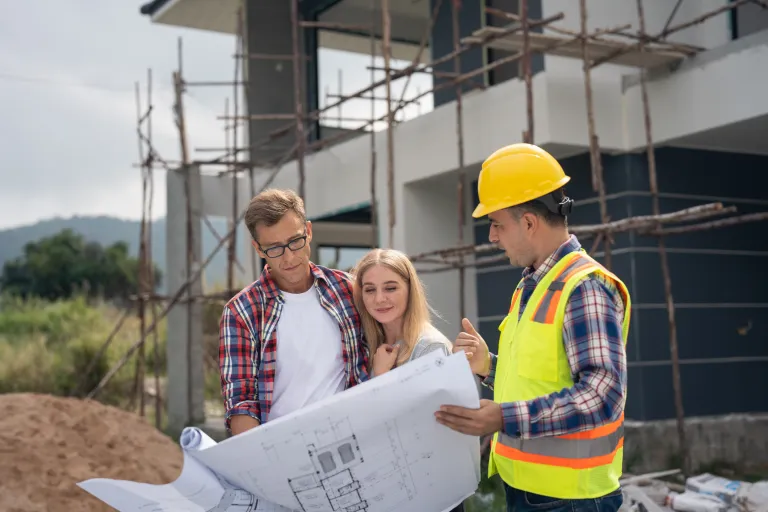Homebuyers often weigh the choice between a new build and an existing home. While new homes may come with a higher price tag, they offer major advantages—modern design, smart technology, energy efficiency, and customizable features. Buyers can also enjoy lower maintenance costs, builder warranties, and amenities in new communities.
Although higher costs have deterred some, the price difference between new and existing homes is narrowing fast. Discover what’s driving this shift and how your location could impact your options.
New vs. Existing Home Prices: The Gap Is Narrowing
The price difference between new and existing homes is shrinking fast. In Q1 2025, the median price for a new single-family home was $416,900—just $14,600 more than an existing home at $402,300, according to the U.S. Census Bureau and the National Association of Realtors. That’s a major shift from 2023, when the gap was $64,000, and even more dramatic compared to the 2010s, when it averaged $66,000.
New home prices dropped 2.32% year-over-year and have declined for eight consecutive quarters, according to the National Association of Home Builders. Meanwhile, existing home prices rose 3.38% from the previous year, marking seven straight quarters of growth.
Older homes (30+ years) sold for 15% less than the median in 2024—down from an 18.9% discount in 2012. At the same time, homes under five years old sold for just 11.8% above the median, a steep drop from the 44.4% premium seen in 2012.
As premiums for new builds shrink and discounts for older homes fade, the market is evolving—and buyers are taking notice.
Read More: 15 Sustainable Xeriscape Ideas for a Beautiful, Low-Water Yard
Why New and Existing Homes Now Sell at Similar Prices
The shrinking price gap between new and existing homes comes down to several key market shifts.
Pandemic-era disruptions continue to affect the housing market. Both new and existing home prices surged due to supply shortages and rising construction costs. While prices for new builds have since stabilized, existing home prices keep climbing—driven by limited inventory.
High mortgage rates are another major factor. Many homeowners locked in low rates during the pandemic and are now reluctant to sell, which tightens supply and pushes up prices for resale homes.
Meanwhile, homebuilders are adapting. To keep costs down, they’re constructing smaller homes on smaller lots—like townhouses, which now represent 20% of new construction. Builders are also offering buyer incentives, helping keep new home prices steady or even lower in some markets.

How Location Impacts the Price Gap Between New and Existing Homes
While the price gap between new and existing homes is narrowing overall, regional differences remain significant.
In Q1 2025, the Midwest had the lowest home prices—$367,500 for new builds and $297,800 for existing homes. The South followed with a narrower gap: $376,000 for new homes vs. $361,800 for existing ones. In contrast, the Northeast showed the largest disparity, where new homes averaged $784,900 compared to $482,700 for existing properties. Interestingly, the West was the only region where existing homes cost more, averaging $626,000 versus $522,100 for new construction.

Construction costs vary by region, driving these differences. Areas like the Sun Belt and Mountain West see more new builds due to lower costs. Meanwhile, rising prices in older metros stem from high demand and limited new construction, especially for aging homes in established cities.
Frequently Asked Questions
Can a brand-new home actually cost less than an existing home?
Yes, in some markets, new homes are now competitively priced or even cheaper than existing homes. This is due to builder incentives, changing construction strategies, and the rising cost of older home inventory.
Why is the price gap between new and existing homes shrinking?
The gap is closing because builders are offering smaller, more affordable homes and incentives, while limited resale inventory is driving up prices of existing homes.
Are new homes more affordable in certain regions?
Yes. Regions like the South and Midwest tend to offer more affordable new construction due to lower land and labor costs. In contrast, new homes remain pricier in areas with high construction expenses like the Northeast.
What are the financial advantages of buying a new home?
New homes typically come with energy-efficient systems, lower maintenance costs, warranties, and modern features, which can save buyers money over time—even if the upfront cost is slightly higher.
Do new homes hold their value better than older homes?
New homes often retain value well, especially when built in growing communities. However, long-term appreciation depends on location, market trends, and overall home quality.
How are builders making new homes more affordable?
Builders are constructing smaller homes, using cost-effective materials, offering townhomes, and providing incentives like rate buy-downs or closing cost assistance to attract buyers.
Should I wait to buy a new home if prices are trending down?
Not necessarily. While new home prices have softened, rising mortgage rates or low inventory may offset potential savings. Buying now with builder incentives could be a smart move.
Conclusion
The once-wide gap between new and existing home prices is rapidly narrowing—reshaping how buyers view their options. With modern features, energy efficiency, and builder incentives, new construction offers strong value, especially as the cost of older homes continues to rise. While location still plays a major role in affordability, today’s market shows that buying a brand-new home may not only be within reach—it could also be the smarter long-term investment.











